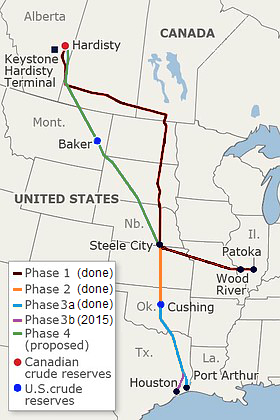You are hereBlogs / Steve Horn's blog / Explosive Virginia Train Carried Fracked Bakken Oil, Headed to Potential Export Facility
Explosive Virginia Train Carried Fracked Bakken Oil, Headed to Potential Export Facility
Cross-Posted from DeSmogBlog
Platts confirmed CSX Corporation's train that exploded in Lynchburg, Virginia was carrying sweet crude obtained via hydraulic fracturing ("fracking") in North Dakota's Bakken Shale basin. CSX CEO Michael Ward has also confirmed this to Bloomberg.

Photo Credit: Erin Ferrell - ABC 13 News | Twitter
"Trade sources said the train was carrying Bakken crude from North Dakota and was headed to Plains All American's terminal in Yorktown," Platts explained. "The Yorktown facility can unload 130,000 b/d of crude and is located on the site of Plains oil product terminal."
In January, the U.S. Department of Transportation's Pipeline and Hazardous Materials Safety Administration issued a Safety Alert concluding Bakken crude is more flammable than heavier oils. Hence the term "bomb trains."
At least 50,000 gallons of the oil headed to Yorktown is now missing, according to ABC 13 in Lynchburg. Some of it has spilled into the James River, as previously reported on DeSmogBlog.
A map available on CSX's website displaying the routes for its crude-by-rail trains offers a clear indication of where the train was headed.

Map Credit: CSX Corporation
Formerly a refinery owned by Standard Oil and then BP/Amoco, Plains All American has turned the Yorktown refinery into a mega holding facility.
Yorktown may become a key future site for crude oil exports if the ban on exports of oil produced domestically in the U.S. is lifted.
Yorktown: Future Oil Export Mecca?
In February, Plains CEO Greg Armstrong said on the company's quarter four earnings call that Yorktown is ideally situated geographically to become an oil export mecca if the ban is lifted.
When asked by an analyst from Bank of America about the ongoing debate over lifting the crude oil export ban, Armstrong discussed how Plains could stand to profit from exports.
"Ultimately we’re positioned, we think well for either answer if they allow blanket exports we have assets in the right places that can help build that market niche," said Anderson.
Harry Pefanis, President and COO for Plains, sang a similar tune to Anderson.
"I guess if I also just add to that if there was export...we’ve got couple of locations that we could load ocean-going vessels. Yorktown is a location where we can rail-in and load out an ocean-going vessel," Pefanis explained.
The industry lobbying effort to lift the U.S.-produced oil export ban has picked up major steam in 2014, with the geopolitical crisis in Ukraine and Russia serving as the hook.
Keystone XL Connection
It's only a matter of time until the familiar oil industry overture begins. That is, pointing to the Lynchburg disaster as the reason why the northern leg of TransCanada's Keystone XL tar sands pipeline must be built.
After all, the same thing happened after the Burlington Northern Santa Fe (BNSF) freight train carrying Bakken oil exploded in Casselton, North Dakota in December 2013.
What the industry and oil-soaked politicians are unlikely to discuss, though, is the Plains All American connection to Keystone XL. That connection comes in the form of Cushing, Oklahoma, home of another key Plains crude oil holding facility.
Founded in 1993, Plains' "first major asset" was its Cushing holding facility, according to the company's website. At the time, it had a storage capacity of 2 million barrels per day, though the facility has grown immensely since then.
In November 2010, Plains announced it would open an additional four million barrels of storage capacity at its Cushing Terminal Facility. That upped its capacity to 18 million barrels per day.
Why the massive increase?
Enter the original TransCanada Keystone pipeline, or Phase 1 in industry lingo. The original TransCanada Keystone 1 runs from Alberta to Steele City, Nebraska.
But it now extends down to Cushing, Oklahoma, Port Arthur, Texas, and Houston because Keystone XL's southern leg (rebranded the Gulf Coast Pipeline Project and Houston Lateral Pipeline) opened for business in January 2014 thanks to an Obama White House March 2012 Executive Order.

Image Credit: Wikimedia Commons
The November 2010 expansion revolved around ingesting the glut of oil flooding Cushing from the Keystone Pipeline system into Plains' holding facility.
"[The] expansion consists of making a high-capacity connection to Keystone Pipeline," explains a Plains press release. "The Partnership plans to be ready to accept Keystone deliveries in the first quarter of 2011."
Canadian tar sands crude traveling via Keystone XL, since it is extracted north of the border, is fair game for — and likely headed to — the global export market.
If things go Plains All American's way, the Bakken fracked oil headed to its Yorktown facility will head to the global export market like the tar sands crude departing from its Cushing, Oklahoma holding facility.
But CSX's mega-explosion in Lynchburg, Virginia may have put a damper on those dreams for the time being, as public attention is drawn to the risks of shipping oil in "bomb trains."
- Steve Horn's blog
- Login to post comments
-

- Email this page
- Printer-friendly version






